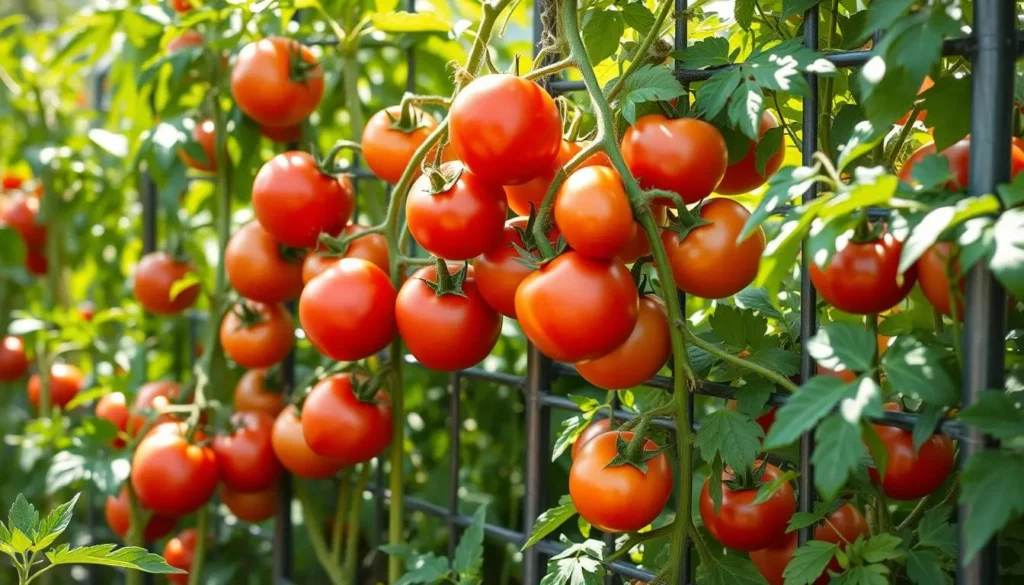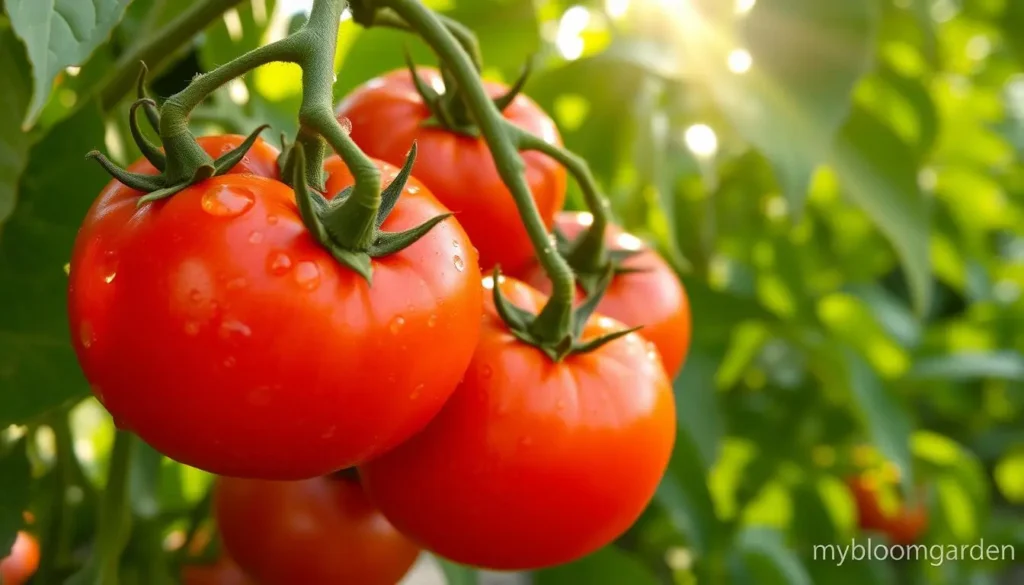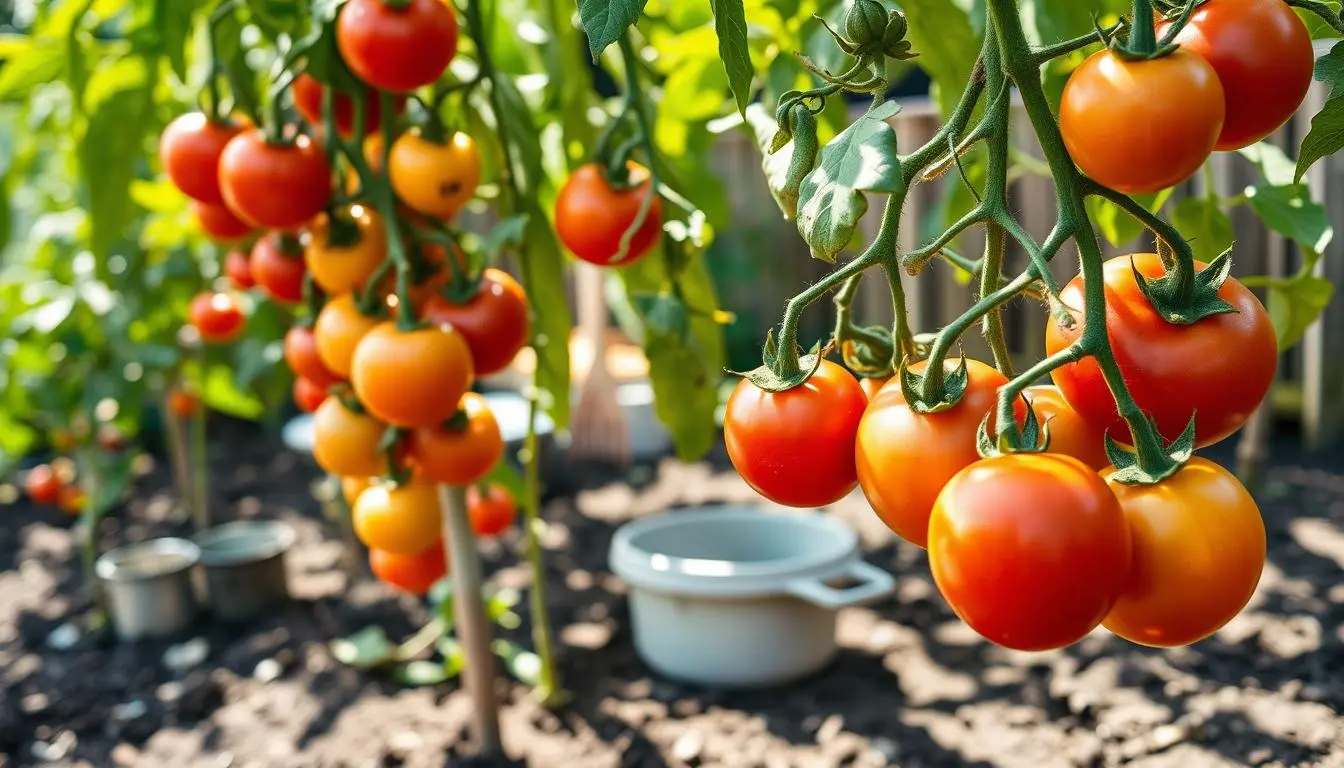As the sun sets, a warm glow falls over the garden. This is where vine tomatoes truly come alive. Their bright colors and flavors have won over many gardeners and food lovers. I’m excited to share their secrets with you.
Vine tomatoes offer a wide range of possibilities for gardeners. From Brandywine to Cherokee Purple, each variety brings its own unique charm. This guide will explore the best ways to grow these delicious fruits in your garden.
Table of Contents
Understanding Vine Tomatoes and Their Characteristics
If you love gardening or cooking, you might know about vine tomatoes. They have a special flavor that’s different from bush tomatoes. Let’s explore what makes vine tomatoes special.
What Makes Vine Tomatoes Different
Vine tomatoes grow on long vines that can get really tall. They don’t grow as compactly as bush tomatoes. This makes them look different and affects their taste and feel.
Benefits of Growing Vine Varieties
Growing vine tomatoes means you get a better taste. They get more sunlight, which makes them taste richer. They’re also juicy and firm, perfect for slicing and canning.
Growth Patterns and Plant Structure
Vine tomato plants grow in a special way. They keep growing and making fruit all season. Unlike bush tomatoes, they need support to grow big. This means you can keep picking tomatoes as they ripen.
To enjoy vine tomatoes, you need to know how they grow. By understanding their unique traits, you can make amazing dishes.
Best Growing Conditions for Vine Tomatoes
To grow vine tomatoes well, knowing the best growing conditions is key. These tomatoes need specific soil, sunlight, water, and temperature. The right environment helps them grow strong and gives you a big harvest.
Soil Requirements
Vine tomatoes love well-drained, rich soil with a pH of 6.0 to 6.8. Add compost to make the soil better. Stay away from heavy clay soils to avoid root rot and slow growth.
Sunlight Needs
How to grow vine tomatoes also means giving them enough sun. They need 6-8 hours of direct sun a day, more is better. Pick a spot that gets lots of sun to help your tomatoes taste great.
Watering Schedule
- Vine tomatoes need steady, even moisture to grow well.
- Water them deeply, 1-2 inches a week, adjusting for weather.
- Don’t let the soil get too wet or too dry, as it can harm the plants and reduce tomato production.
Ideal Temperature Range
Vine tomatoes like warm days of 70°F to 85°F and cooler nights of 60°F. Keep them safe from cold and frost, as they can’t handle it well.
“The key to growing thriving vine tomatoes is providing the right environmental conditions – from nutrient-rich soil to ample sunlight and consistent watering.”
By knowing and meeting vine tomatoes’ specific needs, you can make the best environment for them. This will help them grow well and give you a big, tasty harvest.
Popular Heirloom Vine Tomato Varieties
Exploring vine tomatoes, you’ll find many heirloom varieties. They are loved for their unique tastes, looks, and histories. Here are three heirloom vine tomatoes that will make your garden and kitchen better.
Brandywine Tomatoes
The Brandywine tomato is a classic. It’s known for its amazing taste and big size. These tomatoes have a deep purple-red color and a soft texture.
They taste complex, with a mix of sweet and tangy. This makes them great for many dishes.
Cherokee Purple
The Cherokee Purple tomato is another favorite. It’s known for its beautiful colors. The tomato has deep purple, brown, and green, making it stand out.
Its flavor is rich and smoky. This has made it a favorite among tomato lovers.
German Johnson
The German Johnson tomato is our last heirloom variety. It’s big and pink, with a sweet taste. Its meaty texture and size make it perfect for slicing and canning.
These heirloom vine tomatoes show the variety of tomatoes. They offer unique flavors and colors. Each variety is a delight for the senses.
Modern Hybrid Vine Tomato Varieties
Heirloom tomatoes are known for their unique taste. But, modern hybrid vine tomatoes are gaining fans for their disease resistance, better yield, and taste. These new tomatoes mix the best traits from different tomato types. They grow well in many conditions.
Hybrid vine tomatoes stand out because they resist common tomato diseases. This includes Fusarium and Verticillium wilts, and other fungal and bacterial infections. This makes them great for new gardeners or those with tough growing spots.
These tomatoes also produce more and last longer than heirlooms. This is good news for both home gardeners and commercial growers. They want a reliable and plentiful tomato crop.
Modern hybrid vine tomatoes have improved a lot in taste. They might not taste as complex as some heirlooms. But, they offer a juicy and tasty tomato experience that many enjoy.
“Hybrid vine tomatoes offer the best of both worlds – the disease resistance and productivity of modern cultivars combined with the delicious flavor that tomato lovers crave.”
As gardeners look at all the vine tomatoes out there, hybrids are becoming more popular. They are known for their flexibility, dependability, and great taste.
Cherry and Grape Vine Tomatoes for Small Spaces
If you have a small garden or a balcony, cherry and grape vine tomatoes are great. They grow well in little space and give lots of sweet tomatoes. You don’t need a lot of room for these plants.
Sun Gold Tomatoes
The Sun Gold cherry tomato is loved for its sweet taste and bright color. It grows lots of small tomatoes that are perfect for eating fresh or in salads. Sun Gold does well in small spaces, making it great for city gardens.
Sweet 100
The Sweet 100 cherry tomato is as sweet as its name suggests. These small tomatoes grow in long clusters on a vine. They’re great for eating fresh or in sauces. Their size makes them perfect for small gardens.
Juliet Grape Tomatoes
Juliet grape tomatoes are sweet and tangy. They grow in clusters on a vine, making them perfect for containers. These tomatoes stay firm when cooked, making them versatile in the kitchen.
These vine tomato varieties are perfect for small gardens. You can grow vine tomatoes on a patio, balcony, or tiny garden. They ensure you get a lot of tomatoes from a small space.
Disease-Resistant Vine Tomatoes for Beginners
Starting to grow vine tomatoes can seem tough, especially if you’re new to gardening. But, there are many disease-resistant vine tomato varieties that make it easier. These plants are perfect for beginners, offering a simple way to get lots of tomatoes.
The Brandywine tomato is a great choice. It’s famous for its delicious taste and fights off diseases like early and late blight. Another favorite is the Cherokee Purple, known for its deep color and strong fight against Septoria leaf spot.
If you prefer something newer, try the Juliet grape tomato. It’s a hybrid that’s easy to grow and fights off Fusarium and Verticillium wilt. This makes it a great pick for growing vine tomatoes.

When picking disease-resistant vine tomatoes, think about your local growing conditions. Choose varieties that do well in your area. With the right plants and care, even new gardeners can enjoy growing vine tomatoes and get a big harvest.
Supporting and Trellising Your Vine Tomatoes
Supporting and trellising vine tomatoes is key for their health and harvest. The right support system helps your plants grow well and produce lots of tasty tomatoes.
Types of Support Systems
There are many ways to support vine tomatoes. Here are some popular ones:
- Cages: Wire or metal cages that provide a sturdy frame for the plant to climb and grow upwards.
- Trellises: Vertical structures made of wood, metal, or wire that allow the vines to climb and spread out.
- Stakes: Single posts or stakes driven into the ground, with the plant tied to the stake as it grows.
- Tomato ladders: Tiered structures that provide multiple levels of support as the plant matures.
Training and Pruning Methods
Training and pruning are also important for vine tomatoes. Here are some key practices:
- Pinching or pruning suckers: Removing the small shoots that emerge between the main stem and the leaves helps concentrate the plant’s energy into fruit production.
- Tying or clipping the vines: Gently securing the vines to the support system as they grow helps them climb and spread out evenly.
- Removing lower leaves: Stripping off the lower leaves allows more air circulation and light penetration, reducing the risk of disease.
Maintenance Throughout Growing Season
Keeping your vine tomato support system in good shape is important all season. Check for any loose or damaged parts and make adjustments as needed. This ensures your plants stay strong and healthy as they grow and produce fruit.
By using the right how to vine tomatoes and garden practice techniques, you can make your vine tomato plants thrive. This leads to a big harvest of delicious, vine-ripened tomatoes.
Harvesting and Storage Tips for Vine-Ripened Tomatoes
Enjoying the fruits of your labor with homegrown ripe vine tomatoes is the best part of gardening. To get the most flavor and keep them fresh, follow these key tips for harvesting and storing.
Timing is Everything
The best time to pick your tomatoes is when they’re fully colored and soft to the touch. Don’t pick them too soon, as they might not ripen well after picking. Watch them closely and pick when they’re plump, juicy, and ready for cooking.
Proper Harvesting Techniques
- Gently twist and pull the tomato from the vine, leaving a short stem attached.
- Handle the ripe vine-tomatoes with care, avoiding any bruising or damage to the delicate skin.
- Harvest in the morning when the fruits are cooler, and avoid picking during the hot midday sun.
Storage Solutions
To keep your fresh tomatoes fresh longer, follow these easy storage tips:
- Store whole, unwashed tomatoes at room temperature, away from direct sunlight.
- Place them stem-side down on a clean, dry surface, allowing for air circulation.
- Avoid refrigerating whole tomatoes, as the cold temperature can compromise flavor and texture.
- For longer-term storage, consider canning, freezing, or drying your excess ripe vine tomatoes.
Learning how to harvest and store your homegrown tomatoes ensures a steady supply of juicy, tasty fruits all season long.

“The secret to growing the perfect tomato lies in the harvest and storage. With the right techniques, you can savor the sweet, tangy goodness of your vine-ripened gems for weeks to come.”
Common Problems and Solutions in Growing Vine Tomatoes
Growing vine tomatoes can be rewarding but comes with challenges. Gardeners face issues like disease prevention and pest management. Knowing these problems and their solutions is crucial for a healthy harvest.
Disease Prevention
Vine-tomatoes are prone to diseases like early blight, late blight, and fusarium wilt. To avoid these, maintain good garden hygiene. This includes:
- Rotating your crop location annually to break disease cycles
- Providing proper air circulation around the plants
- Promptly removing any diseased leaves or fruit
- Using disease-resistant vine tomato varieties when possible
Pest Management
Vine tomatoes can also face pests like aphids, hornworms, and spider mites. To fight these pests, try these methods:
- Regularly inspect your plants for signs of pest activity
- Use organic pest control methods, such as introducing beneficial insects or applying neem oil
- Implement physical barriers, like row covers, to keep pests at bay
- Practice good sanitation by removing any infested plant material
Environmental Stress Factors
Environmental conditions can also affect vine-tomatoes. Issues like extreme temperatures, drought, and excessive moisture can harm your plants. To help your tomatoes thrive, consider:
- Providing consistent, adequate moisture through regular watering
- Protecting your plants from sudden temperature fluctuations
- Ensuring proper drainage to prevent waterlogging
- Applying mulch to conserve soil moisture and suppress weed growth
By tackling these common problems and using the right solutions, you can overcome challenges. This way, you can enjoy a bountiful harvest from your garden.
Companion Plants for Vine Tomatoes
Make your vine tomato garden better by adding the right plants. Some plants can make your tomatoes taste better, grow stronger, and keep pests away. They also help the soil.
Basil is a top choice for tomatoes. It keeps away aphids and spider mites and tastes great with tomatoes. Borage is also great. It draws in ladybugs and lacewings, which eat tomato pests.
- Marigolds keep nematodes away, tiny pests that harm tomato roots.
- Nasturtiums’ bright flowers attract aphids, keeping them off your tomatoes.
- Mint at the garden’s edge keeps insects away.
Avoid planting tomatoes with cole crops, fennel, and dill. They can harm tomato growth and taste. Choose plants that help your tomatoes grow well and taste great.
“Companion planting is a garden practice that can yield impressive results for your vine tomatoes.”
By picking the right plants, you can make a garden that’s not just pretty. It will also give you a great harvest of vine tomatoes.
Conclusion
Vine tomatoes bring a world of flavors and textures to your garden. They range from classic heirlooms like Brandywine to the vibrant Sun Gold hybrids. Exploring vine tomatoes is a rewarding journey for any gardener.
Compared to other tomatoes, like Roma, vine tomatoes have a richer taste and juicier texture. Their unique growth makes them a beautiful addition to any garden. They add a stunning visual element to your space.
Whether you’re experienced or new to growing tomatoes, try out different vine tomato varieties. With the right care, you can enjoy a full season of delicious harvests. Happy gardening!

